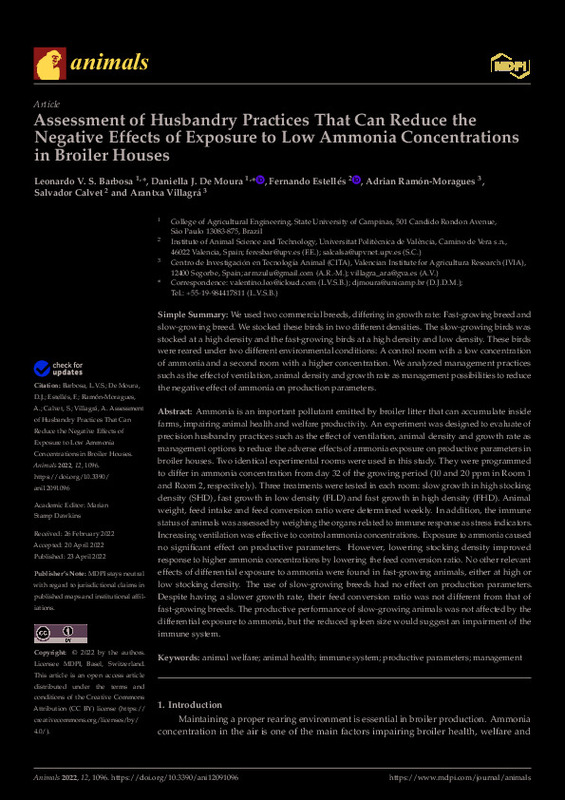JavaScript is disabled for your browser. Some features of this site may not work without it.
Buscar en RiuNet
Listar
Mi cuenta
Estadísticas
Ayuda RiuNet
Admin. UPV
Assessment of Husbandry Practices That Can Reduce the Negative Effects of Exposure to Low Ammonia Concentrations in Broiler Houses
Mostrar el registro sencillo del ítem
Ficheros en el ítem
| dc.contributor.author | Barbosa, Leonardo V. S.
|
es_ES |
| dc.contributor.author | De Moura, Daniella J.
|
es_ES |
| dc.contributor.author | Estellés, F.
|
es_ES |
| dc.contributor.author | Ramon-Moragues, Adrian
|
es_ES |
| dc.contributor.author | Calvet, S.
|
es_ES |
| dc.contributor.author | Villagrá, Arantxa
|
es_ES |
| dc.date.accessioned | 2023-05-15T18:01:55Z | |
| dc.date.available | 2023-05-15T18:01:55Z | |
| dc.date.issued | 2022-05 | es_ES |
| dc.identifier.uri | http://hdl.handle.net/10251/193383 | |
| dc.description.abstract | [EN] Simple Summary We used two commercial breeds, differing in growth rate: Fast-growing breed and slow-growing breed. We stocked these birds in two different densities. The slow-growing birds was stocked at a high density and the fast-growing birds at a high density and low density. These birds were reared under two different environmental conditions: A control room with a low concentration of ammonia and a second room with a higher concentration. We analyzed management practices such as the effect of ventilation, animal density and growth rate as management possibilities to reduce the negative effect of ammonia on production parameters. Ammonia is an important pollutant emitted by broiler litter that can accumulate inside farms, impairing animal health and welfare productivity. An experiment was designed to evaluate of precision husbandry practices such as the effect of ventilation, animal density and growth rate as management options to reduce the adverse effects of ammonia exposure on productive parameters in broiler houses. Two identical experimental rooms were used in this study. They were programmed to differ in ammonia concentration from day 32 of the growing period (10 and 20 ppm in Room 1 and Room 2, respectively). Three treatments were tested in each room: slow growth in high stocking density (SHD), fast growth in low density (FLD) and fast growth in high density (FHD). Animal weight, feed intake and feed conversion ratio were determined weekly. In addition, the immune status of animals was assessed by weighing the organs related to immune response as stress indicators. Increasing ventilation was effective to control ammonia concentrations. Exposure to ammonia caused no significant effect on productive parameters. However, lowering stocking density improved response to higher ammonia concentrations by lowering the feed conversion ratio. No other relevant effects of differential exposure to ammonia were found in fast-growing animals, either at high or low stocking density. The use of slow-growing breeds had no effect on production parameters. Despite having a slower growth rate, their feed conversion ratio was not different from that of fast-growing breeds. The productive performance of slow-growing animals was not affected by the differential exposure to ammonia, but the reduced spleen size would suggest an impairment of the immune system. | es_ES |
| dc.description.sponsorship | This research was funded by the National Institute for Agricultural Research and Experimentation and the Ministry of Economy, Industry and Competitiveness (RTA 2017-00013, Programme: MINECO, Ministerio de Economia y Competitividad). The scholarship Capes and Cnpq supported the participation of Leonardo Valentino in this research. We acknowledge CNPq for the participation number 308177/2021-5 and Santander for the Subject Ibero-Americana. | es_ES |
| dc.language | Inglés | es_ES |
| dc.publisher | MDPI AG | es_ES |
| dc.relation.ispartof | Animals | es_ES |
| dc.rights | Reconocimiento (by) | es_ES |
| dc.subject | Animal welfare | es_ES |
| dc.subject | Animal health | es_ES |
| dc.subject | Immune system | es_ES |
| dc.subject | Productive parameters | es_ES |
| dc.subject | Management | es_ES |
| dc.subject.classification | PRODUCCION ANIMAL | es_ES |
| dc.title | Assessment of Husbandry Practices That Can Reduce the Negative Effects of Exposure to Low Ammonia Concentrations in Broiler Houses | es_ES |
| dc.type | Artículo | es_ES |
| dc.identifier.doi | 10.3390/ani12091096 | es_ES |
| dc.relation.projectID | info:eu-repo/grantAgreement/MEC//RTA2007-00013-00-00/ES/CARACTERIZACIÓN Y VALORIZACIÓN DEL SISTEMA AGRO-FORESTAL DEL CASTAÑO/ | es_ES |
| dc.relation.projectID | info:eu-repo/grantAgreement/CNPq//308177%2F2021-5/ | es_ES |
| dc.rights.accessRights | Abierto | es_ES |
| dc.contributor.affiliation | Universitat Politècnica de València. Escuela Técnica Superior de Ingeniería Agronómica y del Medio Natural - Escola Tècnica Superior d'Enginyeria Agronòmica i del Medi Natural | es_ES |
| dc.description.bibliographicCitation | Barbosa, LVS.; De Moura, DJ.; Estellés, F.; Ramon-Moragues, A.; Calvet, S.; Villagrá, A. (2022). Assessment of Husbandry Practices That Can Reduce the Negative Effects of Exposure to Low Ammonia Concentrations in Broiler Houses. Animals. 12(9):1-11. https://doi.org/10.3390/ani12091096 | es_ES |
| dc.description.accrualMethod | S | es_ES |
| dc.relation.publisherversion | https://doi.org/10.3390/ani12091096 | es_ES |
| dc.description.upvformatpinicio | 1 | es_ES |
| dc.description.upvformatpfin | 11 | es_ES |
| dc.type.version | info:eu-repo/semantics/publishedVersion | es_ES |
| dc.description.volume | 12 | es_ES |
| dc.description.issue | 9 | es_ES |
| dc.identifier.eissn | 2076-2615 | es_ES |
| dc.identifier.pmid | 35565524 | es_ES |
| dc.identifier.pmcid | PMC9105042 | es_ES |
| dc.relation.pasarela | S\466594 | es_ES |
| dc.contributor.funder | Ministerio de Educación y Ciencia | es_ES |
| dc.contributor.funder | Coordenaçao de Aperfeiçoamento de Pessoal de Nível Superior, Brasil | es_ES |
| dc.contributor.funder | Conselho Nacional de Desenvolvimento Científico e Tecnológico, Brasil | es_ES |
| dc.contributor.funder | Instituto Nacional de Investigación y Tecnología Agraria y Alimentaria | es_ES |








